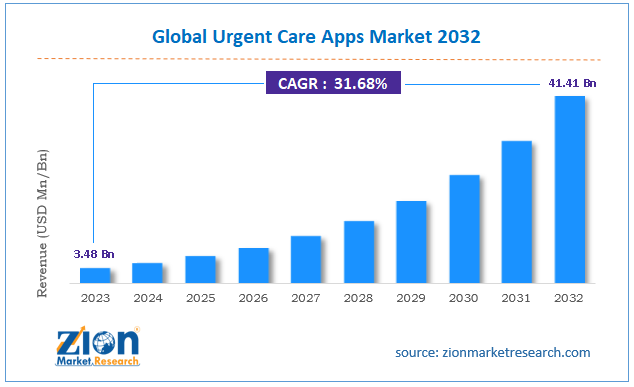In this fast-paced world, having access to healthcare services is really necessary, particularly in those cases that require immediate attention. Individuals now have quick access to medical advice, consultations, and urgent care services whenever and wherever they choose due to the growth of urgent care apps, which have become vital tools. Within the scope of this analysis, we investigate the market for urgent care apps, examining its size, share, trends, and forecasts up to the year 2032.
Urgent Care Apps Market Size and Share:
In 2023, the global urgent care apps market was valued at approximately $3.48 billion. By 2032, experts anticipate that this market will have grown to over $41.41 billion, with a compound annual growth rate (CAGR) of about 31.68%.

Many different kinds of mobile apps that link people in need of immediate medical attention to doctors and hospitals make up what is known as the urgent care apps market. Among the many features offered by these applications are the ability to schedule appointments, take medication, evaluate symptoms, and conduct virtual consultations. Rising smartphone ownership, customer interest in on-demand medical treatment, and the practicality of telemedicine have all contributed to the rapid expansion of the urgent care applications industry, according to recent statistics. People who need quick medical advice or treatment have flocked to urgent care applications, driving up the market size.
https://www.zionmarketresearch.com/sample/urgent-care-apps-market-size
The global urgent care apps market is led by players like:
- Doctor on Demand
- Teladoc Health Inc.
- MDLIVE
- Push Doctor
- Amwell
- PlushCare
- CureFit
- Maple
- HealthTap
- HaloDoc
- MeMD
- Zipnosis
- KRY (LIVI)
- SwyftMD
- Pager
Urgent Care Apps Market Trends:
Several trends are shaping the urgent care apps market:
- Telemedicine Integration: Urgent care apps are increasingly integrated with telemedicine platforms, allowing users to access virtual consultations with licensed healthcare providers in real-time. This trend enables timely assessment and treatment of urgent health concerns, reducing the need for in-person visits to traditional healthcare facilities.
- AI-driven Symptom Assessment: Many urgent care apps utilize artificial intelligence (AI) algorithms to conduct symptom assessments and provide personalized recommendations based on users’ reported symptoms and medical history. AI-driven symptom checkers enhance the accuracy and efficiency of virtual consultations, enabling users to receive appropriate care recommendations quickly.
- Medication Delivery Services: Some urgent care apps offer medication delivery services, allowing users to receive prescribed medications directly to their doorstep. This trend enhances the convenience of urgent care app usage, especially for individuals with limited mobility or those seeking prompt access to necessary medications.
Forecast to 2032:
Looking ahead, the urgent care apps market is expected to continue its upward trajectory, driven by the following factors:
- Increased Smartphone Adoption: The widespread adoption of smartphones and mobile devices worldwide will fuel the demand for urgent care apps, as more individuals seek convenient healthcare solutions accessible from their mobile devices.
- Rising Healthcare Costs: The rising cost of traditional healthcare services, coupled with the convenience and affordability of urgent care apps, will drive continued adoption among consumers seeking cost-effective alternatives for non-emergency medical needs.
- Expansion of Telemedicine Regulations: The evolving regulatory landscape surrounding telemedicine and virtual care will facilitate the expansion of urgent care apps, enabling greater integration with healthcare systems and reimbursement mechanisms.
Conclusion:
In conclusion, the urgent care apps market presents significant opportunities for growth and innovation as we progress towards 2032. By leveraging technological advancements, addressing consumer needs for immediate medical assistance, and adapting to regulatory changes, stakeholders in the urgent care apps market can play a crucial role in enhancing access to timely healthcare services and improving health outcomes for individuals worldwide.


